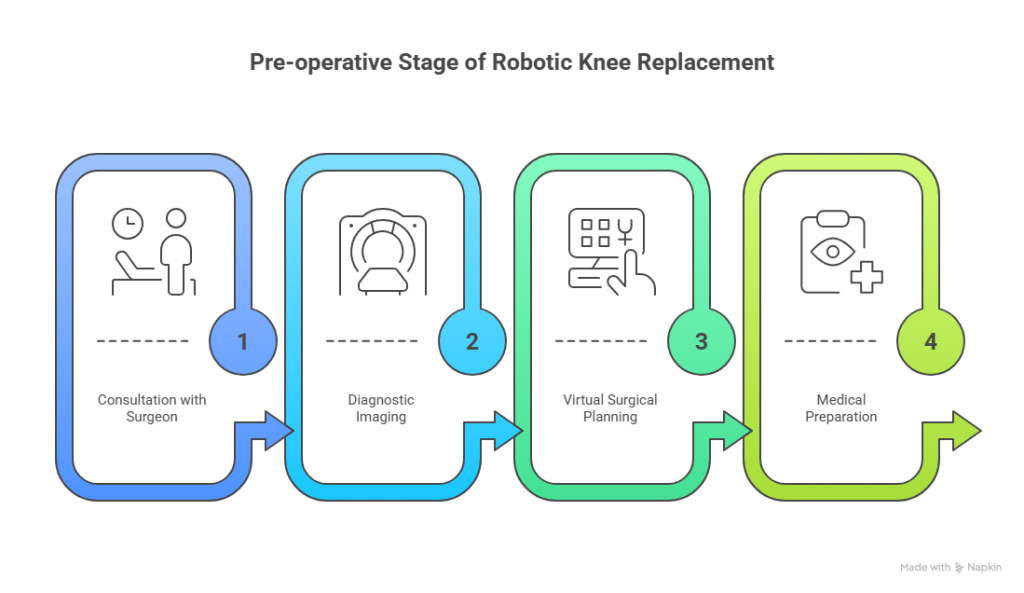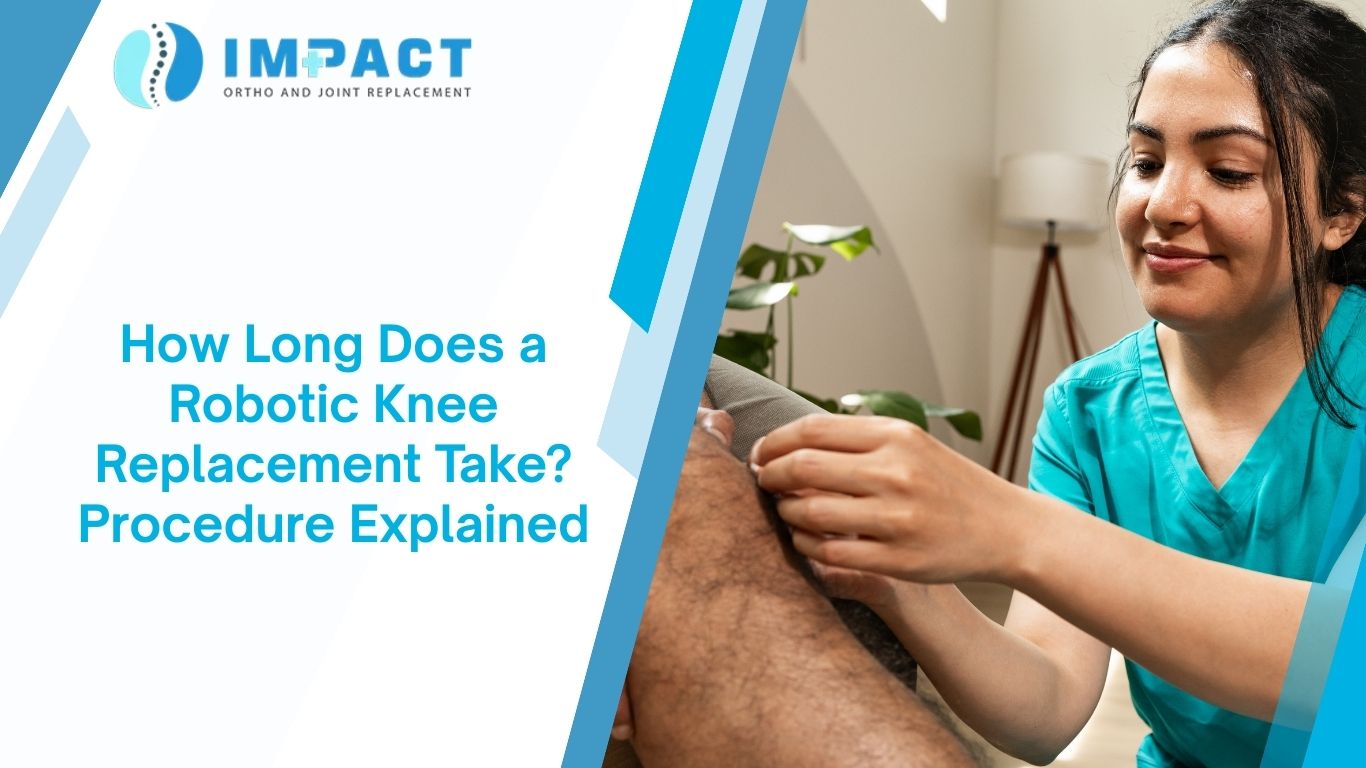I understand you’re curious about a very specific and important question: How Long Does a Robotic Knee Replacement Take? It’s a question that gets right to the heart of what to expect on the day of your surgery. And while the simple answer might be a number, the more meaningful answer lies in understanding the entire process, from the moments before you step into the operating room to the crucial steps that follow.
Let’s embark on this journey together and break down the timeline, so you have a complete picture of what to expect. This isn’t just about the surgery; it’s about the precision and care that go into every phase, all of which contribute to the success of your new joint.
The Short Answer: The Intra-operative Time
If you’re just looking for a number, the actual time spent in the operating room for the surgical part of the procedure is typically between 1 and 2 hours. This is comparable to the time it takes for a traditional knee replacement surgery. In some cases, because of the enhanced efficiency of the robotic system, the actual bone preparation and implant placement might be slightly faster once the setup is complete. So, in terms of the hands-on part of the surgery, that’s your answer to How Long Does a Robotic Knee Replacement Take.
But my friend, that number only tells a small part of the story. The true value of a robotic knee replacement lies in the meticulous preparation that happens before the surgeon even makes the first incision, and the recovery that follows. So, let’s explore the total timeline to give you a comprehensive understanding.
How Long Does a Robotic Knee Replacement Take? – Procedure Explained
Want to know the exact time and recovery process for robotic knee replacement? Get expert insights and personalized guidance for a smooth treatment journey.
Book Appointment with Knee ExpertPhase 1: The Pre-operative Stage – The Foundation of Precision

When you ask, “How Long Does a Robotic Knee Replacement Take?” the answer truly begins weeks before your surgery date. This is the stage where the magic of robotic-assisted surgery truly sets it apart from traditional methods. This is where your surgeon customizes the entire procedure for your unique anatomy.
The Consultation and Diagnostic Imaging: Your journey starts with a consultation with your orthopedic surgeon. They will diagnose your condition, discuss your pain and mobility issues, and determine if a knee replacement is the right option for you. If a robotic knee replacement is chosen, the next step is often a diagnostic CT scan or MRI of your knee. This is a crucial step and a key differentiator. The imaging is not just for a static picture; it’s used to create a highly detailed, 3D digital model of your knee joint.
Virtual Surgical Planning: Once the 3D model is created, your surgeon uses specialized software to virtually perform your surgery on a computer screen. This is a game-changer. They can precisely map out the size and position of your implant, determine the exact angles and depths for bone cuts, and even simulate your knee’s motion and ligament balance with the new implant—all before you ever set foot in the hospital. This meticulous planning ensures that there are no surprises on the day of surgery, leading to a smoother and more efficient procedure. The time and effort spent in this phase are what make the actual surgical time so efficient and precise. It’s a fundamental part of the answer to How Long Does a Robotic Knee Replacement Take.
Medical Preparation: During this phase, you will also undergo standard pre-operative preparations, such as a physical exam, lab tests, and a consultation with the anesthesiologist to ensure you are healthy and ready for surgery. You may also attend a pre-operative class to learn about the procedure and what to expect during your hospital stay and recovery.
Phase 2: The Intra-operative Stage – The Moment of Truth
This is the part of the journey where your question, “How Long Does a Robotic Knee Replacement Take?” is most directly answered. As we discussed, the surgical time itself is generally 1-2 hours, but let’s break down what happens during that time.
Anesthesia and Positioning (approximately 15-30 minutes): First, you will be taken to the operating room and given anesthesia. This could be general anesthesia (where you are asleep) or spinal anesthesia (where you are awake but numb from the waist down). Your surgeon and their team will then carefully position you and prepare the knee for surgery.
Surgical Incision and Exposure (approximately 15 minutes): The surgeon will make a small incision to expose the knee joint. This is a standard step in any knee replacement procedure.
Robotic Registration and Mapping (approximately 15-20 minutes): This is where the robotic-assisted part of the procedure begins. The surgeon will attach small sensors to your knee bones. These sensors communicate with the robotic system, creating a dynamic, real-time map of your knee’s unique anatomy and motion. This step is critical because it links your actual knee to the virtual 3D plan created in Phase 1. The robotic system can now track the precise position of your knee with incredible accuracy.
Robotic-Assisted Bone Preparation (approximately 20-30 minutes): Now, the surgeon uses the robotic arm or guidance system to perform the bone cuts. The robotic system provides haptic feedback, which is like a virtual safety zone, preventing the surgeon from cutting outside the planned area. This ensures the bone cuts are made with sub-millimeter precision, leading to a perfect fit for the implant. The efficiency here is a direct benefit of the pre-operative planning, and it’s what makes the total operating room time for a robotic knee replacement so predictable.
Implant Placement and Trial (approximately 10-15 minutes): Once the bone is prepared, the surgeon will place the trial implant to check for fit and stability. The robotic system provides real-time data on the knee’s motion and ligament tension, allowing the surgeon to make any necessary micro-adjustments to achieve perfect balance. The final, permanent implant is then cemented or fitted into place.
Closure (approximately 10 minutes): The final step is to close the incision and dress the wound. The surgeon will ensure everything is clean and secure.
How Long Does a Robotic Knee Replacement Take? – Procedure Explained
Want to know the exact time and recovery process for robotic knee replacement? Get expert insights and personalized guidance for a smooth treatment journey.
Book Appointment with Knee ExpertPhase 3: The Post-operative Stage – The Real Journey Begins
While the answer to How Long Does a Robotic Knee Replacement Take in the operating room is relatively short, the true recovery is a marathon, not a sprint. The benefits of the robotic precision often translate into a smoother, more efficient recovery.
Immediate Recovery Room (1-3 hours): After surgery, you will be taken to the recovery room where nurses will monitor you as you wake up from anesthesia. Pain management will begin here.
Hospital Stay (1-3 days): Your hospital stay will likely be brief. During this time, you will begin initial physical therapy, which is crucial. A physical therapist will help you stand up, walk with a walker, and begin your range of motion exercises. The goal is to get you up and moving safely as soon as possible.
At-Home Recovery (weeks to months): The majority of your recovery will happen at home. You will continue outpatient physical therapy for several weeks to months. The a robotic knee replacement’s precision often leads to less pain and swelling, which can make physical therapy more comfortable and productive. You will gradually regain strength, mobility, and confidence, and your surgeon will monitor your progress during follow-up appointments.
Ultimately, while the intra-operative time is a key part of the total experience, the most valuable part of a robotic knee replacement is the comprehensive care, from the virtual planning beforehand to the structured rehabilitation afterward. That’s the real answer to How Long Does a Robotic Knee Replacement Take.
Conclusion: A Short Time for a Lasting Impact
In short, while the surgical procedure for a robotic knee replacement can be completed in about 1-2 hours, the true timeline of care and precision begins well before the surgery and extends into the recovery phase. This comprehensive approach, powered by cutting-edge technology, is designed to give you the most accurate and personalized outcome possible. It’s an investment of time and technology for a lifetime of improved mobility.
The dedicated team at Impact Ortho is at the forefront of this technology, committed to providing you with the most advanced and precise care available. Impact Ortho believes in leveraging the best technology to achieve the best possible outcomes for every patient.
How Long Does a Robotic Knee Replacement Take? – Procedure Explained
Want to know the exact time and recovery process for robotic knee replacement? Get expert insights and personalized guidance for a smooth treatment journey.
Book Appointment with Knee ExpertFAQs: Your Questions Answered About Robotic Knee Replacement
Is a robotic knee replacement a longer procedure than a traditional one?
The surgical time in the operating room is generally similar to a traditional knee replacement. While the robotic setup and mapping might add a few minutes, the precision they offer can make the actual bone preparation and implant placement more efficient. The overall time difference is minimal.
Is the longer pre-operative planning time worth it?
Absolutely. The meticulous pre-operative planning is arguably the most valuable part of the procedure. It allows the surgeon to create a perfectly customized plan for your unique anatomy, leading to superior implant placement, better joint alignment, and a more natural-feeling knee. This level of precision is the key to a better long-term outcome.
Does the robotic system make the recovery faster?
Many patients and surgeons report that recovery can be quicker and less painful with robotic-assisted surgery. The enhanced precision often leads to less soft tissue disruption and more accurate implant placement, which can result in less post-operative pain, reduced swelling, and faster mobilization. This allows patients to start physical therapy sooner and get back to their lives more quickly.
What are the main benefits of the pre-operative planning?
The main benefits are a truly personalized surgical plan, sub-millimeter accuracy in bone cuts, and real-time data on joint balance and motion. This eliminates the guesswork and helps the surgeon achieve optimal alignment, which is critical for the longevity and function of the new knee.
Are all robotic knee replacements the same procedure?
No. There are different types of robotic systems (e.g., active, semi-active, passive navigation), and the specific procedure will vary based on the technology used and the surgeon’s technique. The core principle of using a 3D plan and real-time data remains the same.
How can I find out if a robotic knee replacement is right for me?
The best way to determine if a robotic knee replacement is right for you is to schedule a consultation with an orthopedic surgeon who specializes in this procedure. They will evaluate your condition, discuss the benefits and risks, and help you make an informed decision. You can consult with the specialists at Impact Ortho, who are experts in this field.
How Long Does a Robotic Knee Replacement Take? – Procedure Explained
Want to know the exact time and recovery process for robotic knee replacement? Get expert insights and personalized guidance for a smooth treatment journey.
Book Appointment with Knee Expert










